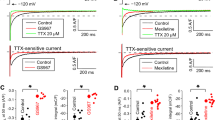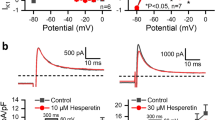Summary
The electrophysiologic mode of action and potency of the verapamil derivative YS 035 (N,N-bis-(3,4-dimethoxyphenethyl)-N-methyl amine) were investigated in sheep cardiac Purkinje fibres. Action potential duration measured at a repolarization level of −60 mV (APD-60) and membrane currents recorded with the two-microelectrode voltage-clamp technique were evaluated. At 10 μmol/l YS 035 APD-60 was increased to about 115% of reference. Prolongation measured as percentage of the respective control exhibited on the average no dependence on stimulation frequency (0.17–2 Hz). At 100 μmol/l membrane became depolarized to about −50 mV and action potentials could no longer be elicited. Further study was focussed on effects on outward currents, mostly activated at a frequency of 0.05 Hz. Transient outward current (ito) was completely blocked at 100 μmol/l and half-maximal inhibition occurred at about 14 μmol/l. Inwardly rectifying potassium current (iK1) was reduced to 47% of reference at 100 μmol/l. An initially activating outward current at positive membrane potentials (iinst) was reduced to 73% at 100 μmol/l. Time-dependent (delayed) outward current (iK) was on the average not affected up to 100 μol/l. Besides inhibition of repolarizing outward currents YS 035 completely blocked pacemaker current (if) at 100 μmol/l and half-maximal reduction was achieved at 5 μmol/l. YS 035 (1–100 μmol/l) did not clearly affect time constants of activation at selected test potentials (IK: +35 mV; if: −90 mV) or inactivation (ito: 0 mV). Voltage-dependent control mechanisms of currents (itto, if) were not influenced by YS 035 but the amount of available current was reduced.
In conclusion, the verapamil derivative YS 035 inhibited pacemaker current and potassium outward currents which correlated to a prolongation of cardiac action po tentials. Electrophysiological actions of the compound favour it to be tested in vivo as an antiarrhythmic drug candidate.
Similar content being viewed by others
References
Aronson RS, Gelles JM, Hoffman BF (1973) A new method for producing short cardiac Purkinje fibers suitable for voltage clamp. J Appl Physiol 34:527–530
Baumgarten CM, Isenberg G (1977) Depletion and accumulation of potassium in the extracellular clefts of cardiac Purkinje fibres during voltage clamp hyperpolarization and depolarization. Pflügers Arch 368:19–31
Borchard U, Berger F, Hafner D, Kammer T (1988) Inhibitory action of the verapamil-derivative YS 035 on repolarizing currents explains its class III-antiarrhythmic activity. Naunyn-Schmiedeberg's Arch Pharmacol [Suppl] 337:R59
Borchard U, Berger F, Hafner D (1989) Classification and action of antiarrhythmic drugs. Eur Heart J 10 [Suppl]:31–40
Boyett MR, Fedida D (1988) The effect of heart rate on the membrane currents of isolated sheep Purkinje fibres. J Physiol 399:467–491
Boyett MR, Coray A, McGuigan JAS (1980) Cow ventricle I. The effect of extracellular potassium concentration on the current-voltage relationship II. Evidence for a time dependent outward current. Pflügers Arch 389:37–44
Callewaert G, Carmeliet E, Vereecke J (1984) Single cardiac Purkinje cells: general electrophysiology and voltage-clamp analysis of the pace-maker current. J Physiol 349:643–661
Coraboeuf E, Carmeliet E (1982) Existence of two transient outward currents in sheep cardiac Purkinje fibers. Pflügers Arch 392: 352–359
Deck KA, Kern R, Trautwein W (1964) Voltage clamp technique in mammalian cardiac fibres. Pflügers Arch 280:50–62
Di Francesco D, Noble D (1985) A model of cardiac electrical activity incorporating ionic pumps and concentration changes. Philos Trans R Soc Lond (Biol) 307:353–398
Di Francesco D, Ferroni A, Viscutin S (1984) Barium-induced blockade of the inward rectifier in calf Purkinje fibres. Pflügers Arch 402:446–453
Doerr Th, Trautwein W (1990) On the mechanism of the “specific bradycardic action” of the verapamil derivative ULFS 49. Naunyn Schmiedeberg's Arch Pharmacol 341:331–340
Doerr Th, Denger R, Trautwein W (1989) Calcium currents in single SA nodal cells of the rabbit heart studied with action potential clamp. Pflügers Arch 413:599–603
Dukes LD, Morad M (1989) Tedisamil inactivates transient outward K+ current in rat ventricular myocytes. Am J Physiol 257:H1746-H1749
Fedida D, Boyett MR (1985a) Activity-dependent changes in the electrical behaviour of sheep cardiac Purkinje fibres. Proc R Soc Lond (Biol) 225:457–479
Fedida D, Boyett MR (1985b) Mechanisms underlying the shortening of the action potential at high and low stimulus rates in sheep Purkinje fibres. Proc R Soc Lond (Biol) 225:481–502
Fozzard HA, Hiraoka M (1973) The positive dynamic current and its inactivation properties in cardiac Purkinje fibres. J Physiol (Lond) 234:568–586
Hafner D, Berger F, Borchard U, Kullmann A, Scherlitz A (1988) Electrophysiological characterization of the class III activity of sotalol and its enantiomers. New interpretation of use-dependent effects. Arzneimittelforschung 38:231–236
Hondeghem LM, Snyders DJ (1990) Class III antiarrhythmic agents have a lot of potential but a long way to go. Circulation 81:686–690
Imaizumi Y, Giles WR (1987) Quinidine-induced inhibition of transient outward current in cardiac muscle. Am J Physiol 253:H704-H708
Kenyon J, Gibbons WR (1979) 4-aminopyridine and the early outward current of sheep cardiac Purkinje fibers. J Gen Physiol 73:139–157
Kline RP, Kupersmith J (1982) Effects of extracellular potassium accumulation and sodium pump activation on automatic canine Purkinje fibres. J Physiol (Lond) 324:507–533
Noble D, Tsien TW (1968) The kinetics and rectifier properties of the slow potassium current in cardiac Purkinje fibres. J Physiol (Lond) 195:185–214
Noble D, Tsien RW (1969) Outward membrane currents activated in the plateau range of potentials in cardiac Purkinje fibres. J Physiol (Lond) 200:205–231
Noma A, Morad M, Irisawa H (1983) Does the “pacemaker current” generate the diastolic depolarization in the rabbit SA node cells? Pflügers Arch 397:190–194
Osterrieder W Pelzer D, Yang Q, Trautwein W (1981) The electrophysiological basis of the bradycardic action of AQA 39 on the sinoatrial node. Naunyn-Schmiedeberg's Arch Pharmacol 317:223–237
Singh BN, Nademanee K (1985) Control of cardiac arrhythmias by selective lengthening of repolarization: theoretic considerations and clinical observations. Am Heart J 109:421–430
Trautwein W, Pelzer D, McDonald TF, Osterrieder W (1981) AQA 39, a new bradycardic agent which blocks myocardial calcium (Ca) channels in a frequency- and voltage-dependent manner. NaunynSchmiedeberg's Arch Pharmacol 317:228–232
Van Bogaert PP, Goethuls M, Simoens C (1990) Use- and frequency-dependent blockade by UL-FS 49 of the if pacemaker current in sheep cardiac Purkinje fibres. Eur J Pharmacol 187:241–256
Vaughan Williams EM (1975) Classification of antidysrhythmic drugs. Pharmacol Ther B:1 115–138
Vaughan Williams EM (1984) A classification of antiarrhythmic actions reassessed after a decade of new drugs. J Clin Pharmacol 24:129–147
Weis T, Berger F, Borchard U, Hafner D, Piper HM (1990) Pharmacological modulation of transient outward current in rat ventricular myocytes. In: Vereecke J, van Bogaert PP, Verdonck F (eds) Ionic currents and Ischemia. Leuven University Press, Leuven, pp 237–239
Author information
Authors and Affiliations
Additional information
Send offprint requests to U. Borchard at the above address
Rights and permissions
About this article
Cite this article
Berger, F., Borchard, U., Hafner, D. et al. Inhibition of potassium outward currents and pacemaker current in sheep cardiac Purkinje fibres by the verapamil derivative YS 035. Naunyn-Schmiedeberg's Arch Pharmacol 344, 653–661 (1991). https://doi.org/10.1007/BF00174749
Received:
Accepted:
Issue Date:
DOI: https://doi.org/10.1007/BF00174749




